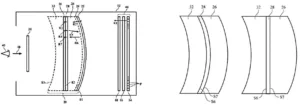The U.S. Patent and Trademark Office recently published a patent application filed by Apple that relates to optical systems for Head Mounted Displays (HMDs). While uses in augmented reality HMDs are discussed in the application, the focus of the inventions is use in virtual reality HMDs.

The patent application, assigned number 15/434623, is entitled “Optical System for Head-Mounted Display.” It was published on February 8, 2018 and assigned publication number 2018/0039052 A1. A copy of the application can be found here.
Providing background information, Apple notes in its filing that conventional head-mounted HMDs are commonly based on the use of a microdisplay and an associated optical system. The function of the optical system is to enlarge the image and present it in a form that is optimised for viewing by the user. The disclosure goes on to note that the arrangement of elements needed in such an optical system can be both bulky and heavy. As a consequence, extended use of a HMD containing such an optical system may be uncomfortable. The inventions disclosed in Apple’s application are intended to address this issue.
The disclosure in Apple’s patent application includes the use of a so-called catadioptric optical system. In addition to other optical components, catadioptric systems incorporate curved mirrors and lenses to refract and reflect light within the optical system. The use of catadioptric optical systems is already fairly common in devices such as microscopes, telescopes and some camera telephoto lenses.
Apple claims that the use of a catadioptric optical system can provide significant benefits in HMD applications. These benefits can be implemented by folding the optical path and using stacks of lenses and mirrors having convex and concave shapes. By such means, it becomes possible to produce a sufficiently large image from a microdisplay while making the entire optical system more compact. It follows that the resulting HMD can be less bulky and/or heavy. Another feature of the catadioptric approach is that it can be effective as a means to minimize chromatic aberration in an optical system.
The patent application includes an illustrative catadioptric based optical system for a HMD. It is presented in the figure below on the left.
Left: An illustrative catadioptric based optical system for use in a HMD. Right: Two examples of a quarter waveplate between a pair of cylindrical lens elements.
In the patent application, Apple notes that, during assembly of the optical system, a flat sheet of quarter waveplate material can be placed between lens elements #32 and #26. Two examples of such inclusion are illustrated in the right hand portion of the figure above. The quarter waveplate material is cemented in place by use of an optical adhesive on either side of the waveplate. In assembling the optical system, these lens elements would be pressed together to spread out the optical adhesive and bend the flexible quarter waveplate material to the shape of the lenses. It is claimed that using a cylindrically curved shape for surfaces S6 and S7 can enable optical system designs in which the thicknesses of lens elements can be reduced.
In addition, the use of cylindrically curved shapes for surfaces S6 and S7 can contribute to the production of a more uniform thickness across the lens elements thereby enhancing their moldability.
Lenses are Injection Molding
Regarding this last point. It is common for lens elements to be formed using injection molding. In this process, the more uniform the thickness of the mold cavity, the more uniform the flow of the hot, liquid plastic during the injection process. The more uniform the flow during injection, the lower the occurrence of flow lines in the resulting lens elements. This is particularly true when the lens element is thicker at the edge than in the center. Achieving uniform flow is particularly important because it results in less birefringence in the finished, molded lens elements. In optical systems, minimizing unwanted birefringence in the lens elements helps to maintain control of the polarization state of the light traversing the optics and forming the image. This, in turn, helps suppress stray light and the introduction of visual artifacts in the image.
In as much as this report relates to a patent application, the timing for bringing any products to market based on the disclosed technology is both uncertain and unknown at this time. -Arthur Berman

